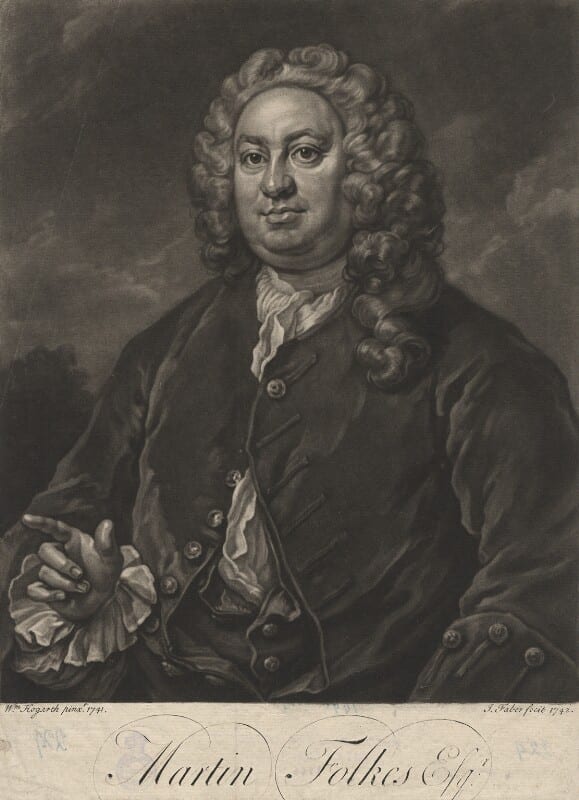by Dr Anna Marie Roos
During my research leave, I spent my time as a visiting fellow at two other institutions, All Souls College at Oxford, and the Huntington Museum and Art Gallery in San Marino California. The topic of my research was Martin Folkes (1690–1754), the subject of a biography I’m writing for Oxford University Press. A protégé of Lincolnshire’s own Sir Isaac Newton, Folkes was from nearby Norfolk. Folkes was an English antiquary (early archaeologist and collector), mathematician, numismatist (coin expert), and astronomer whose unique distinction was his simultaneous presidency of both the Royal Society of London, a renowned scientific academy, and the Society of Antiquaries which is dedicated to studying the material past.
What would being President of a society dedicated to the material past have to do with leading a society dedicated to science? In the 18th century, the ability to observe nature was thought to make scientists ideal to understand the empirical details of ancient artefacts and how they were created. Science and archaeology were seen as one, the Society of Antiquaries and the Royal Society had many common members and held their meetings on the same day, and Folkes tried to unite the two groups into one organisation. If he had succeeded, the humanities and sciences would perhaps be more united today.

Folkes was also part of many social networks…if he were alive today, he would have a lot of Facebook friends and followers on Twitter, yet we have forgotten about him. He was an early Freemason, a participant in French salons where ideas of the day were discussed and a friend of Voltaire, and an art collector. His was an intellectually vibrant world in which the long shadow of Newton—Folkes’s patron and hero—has tended to obscure those who followed him.
Folkes also was the first member of the gentry to marry an actress, Lucretia Bradshaw, which was one of the reasons I was at the Huntington, which has one of the best collections in the world dedicated to early modern drama. I wanted to understand what life was like on the stage for an actress like Lucretia in the 18th century, and was able to read several of the plays in which she performed at Drury Lane Theatre, including her first performance in the Royal Mischief in her teens. Lucretia had a short speaking role. I also found a song she sang playing the daughter of the God Hercules complete with the sheet music which I’m learning to play on the piano. Lucretia and Martin were also world travellers, traveling by coach and sea to Italy in the 1730s, where Folkes as a member of the Royal Society demonstrated Newtonian optics to Venetian nobleman, and he also advised some of his friends there how to use the mathematics of probability to calculate gambling odds. Folkes also met Anders Celsius of the temperature gauge when he was in Venice and a few years after he came back from Italy, he would assist Celsius in calculating the true shape of the Earth (it is slightly flattened at the poles). The couple on their tour brought their parrot, three children, a pet monkey, and a Dutch dog with them. It must have been chaotic.
Folkes also was a big art collector and a patron of Hogarth who did his portrait. And investigating Folkes as an art collector is where my time at the Huntington proved rather exciting. In the 1720s, the records at the Royal Society revealed that Folkes had given a series of mezzotint portraits (a type of early engraving) to Sir Isaac Newton who was President of the Royal Society. The portraits were of past presidents of the Royal Society, and Newton was so flattered by his gift that he had Folkes elected to the Society’s Council. Folkes was good with people, even with the cantankerous Newton. The five portraits hung in the main meeting room at Crane Court in London where the Society met, so Newton would have seen them everyday. But no one knew quite what happened to them.
The Huntington had a couple of auction catalogues of Folkes’s art and book collections which were sold after his death, and I saw in the lists of his collections that Folkes very much favoured the work of mezzotint artist John Smith. That was my clue. With the help of the Royal Society librarian back in London, we tracked down any remaining Smith mezzotints they had left in their vast collection of images, and we found four of the five portraits that Folkes had given to Newton. They were a little worse for wear having been pulled out of their frame, but currently are being restored by the Royal Society. On my return from the Huntington, I went to the Royal Society to see them. One of the portraits was of Christopher Wren, who in addition to being president of the Royal Society was also the architect of St Paul’s Cathedral. It was a thrill thinking that Newton also gazed upon these images as he steered the first government-sponsored scientific Society in the world to international prominence.
If you would like, you can read the blog post I wrote about this discovery for the Huntington, and you can see more about Folkes in this webpage I wrote for the Society of Antiquaries. I hope you enjoy reading more about the remarkable Mr Folkes.
